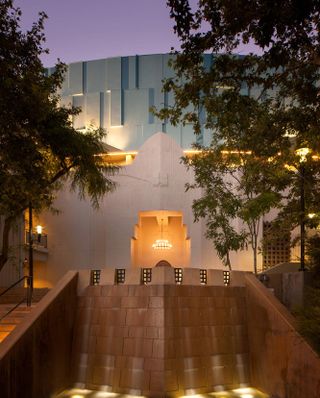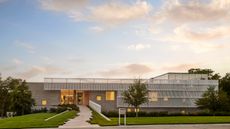Centre stage: Hollywood’s iconic John Anson Ford Theatres reopens after renovation

Stealing the architectural spotlight this summer is the re-opening of Los Angeles’ iconic John Anson Ford Theatres complex. Dating back to 1920 – and nestled in the Hollywood Hills – the open-air theatre is one of LA’s oldest performing arts centres.
The first major renovation of and new construction on the site, which cost $72.2 million, was left in the safe hands of LA-based Levin & Associates Architects – the team behind the revival of much-loved landmarks such as LA City Hall, the Griffith Observatory and the Wiltern theatre.
The sensitive restoration has allowed all of the original elements to shine again. The poured concrete entranceway, designed in 1931 to resemble the gates of Jerusalem, and the turreted concrete towers flanking the amphitheatre stage were carefully restored, while the seating was replaced and the concrete tiered deck repaired and waterproofed.
Yet much of Levin & Associates’ work involved adding function and technology to bring the theatrical relic into the 21st century. One of the main updates was a new, curved, three-storey building with a loading dock, administrative offices and public terrace, which solved many practical difficulties for the complex.

The new amphitheatre stage at night, with the natural backdrop
‘The biggest surprise was how long the Ford operated under the pre-renovation conditions – without the acoustic and theatrical improvements, and the artist and patron amenities,’ says Brenda Levin, architect and founder of Levin & Associates Architects.
A new ‘canyon green and sky blue’ sound wall at the rear of the amphitheatre was designed to reduce noise bleed from nearby Route 101: ‘The new sound wall successfully achieves a major reduction in the ambient freeway noise. In fact, once you close the doors to the theatre, you may hear birds chirping. And the acoustics inside are among the best in the country for an outdoor amphitheatre.’
The theatre also has a new custom-designed decorative metal-panelled control booth, kitted out with the latest recording technology to document the high quality sound and performance.
The amphitheatre stage was completely replaced with a new two-level Brazilian walnut ipe hardwood stage. Beyond the fourth wall, other materials were refreshed in line with the historic style of the theatre, such as a new stone veneer used on the retaining walls and theatrical stairs of the upper stage.

The loading dock and sound wall attached to the new building
‘One of the primary goals of the project was to improve the Ford for the performers. That included providing more dressing rooms, showers and a green room as well as a wider, more useful crossover. The only option was to increase the square footage under the stage and below the amphitheatre seating,’ says Levin, who cannily cut 3,500 sq ft of extra space from the bedrock.
While the impressive surrounding environment is one of the cultural draws of the Ford Theatre, it was something of a logistical mountain for Levin and her team to climb. To make the site sustainable and safe, they had to stabilise the canyon and hillside through erosion control measures and drainage systems, and design new retaining walls. The site itself was a challenge, too.
Thanks to Levin’s hard work, visitor access has been greatly enhanced. The new Zev Yaroslavsky Terrace (The Zev) and Ford Terrace Café provide vital social spaces to linger and enjoy the architecture and the hillside vistas. Landscape designers Mia Lehrer + Associates worked on smoothly blending the space with the surrounding groves of mature trees, planting native Southern Californian species such as two mature coast live oaks and two strawberry madrones (as well as Mediterranean species), and designing a series of stone walls and lighting elements to build atmosphere.
Levin can’t help but feel satisfied: ‘The County now has a totally re-imagined Ford – a state of the art theatre in which any and all artists will enjoy the technical and aesthetic improvements; and for the patrons, a beautiful new picnic terrace with gourmet food options. All accessible for the first time.’

The original, restored entrance, with the new sound wall behind it

A stairway leading down the hillside towards the stage. The hill was stabilised by Levin & Associates with new retaining walls

New audience seating was installed, and elements of the seating area were refurbished with new materials

An internal staircase

A glazed, open walkway in the new building, positioned north of the amphitheatre, adding 11,055 sq ft to the complex

The sound wall adds a contemporary backdrop to the iconic poured concrete architecture

Mia Lehrer + Associates designed the surrounding natural landscape, including stairways that will eventually link up to hiking trails through the Hollywood Hills

The audience’s view of the amphitheatre stage, with natural backdrop

The entrance to the amphitheatre at dusk
INFORMATION
For more information, visit the Levin & Associates Architects website
Wallpaper* Newsletter
Receive our daily digest of inspiration, escapism and design stories from around the world direct to your inbox.
Harriet Thorpe is a writer, journalist and editor covering architecture, design and culture, with particular interest in sustainability, 20th-century architecture and community. After studying History of Art at the School of Oriental and African Studies (SOAS) and Journalism at City University in London, she developed her interest in architecture working at Wallpaper* magazine and today contributes to Wallpaper*, The World of Interiors and Icon magazine, amongst other titles. She is author of The Sustainable City (2022, Hoxton Mini Press), a book about sustainable architecture in London, and the Modern Cambridge Map (2023, Blue Crow Media), a map of 20th-century architecture in Cambridge, the city where she grew up.
-
 10 books culture editor Hannah Silver recommends this winter
10 books culture editor Hannah Silver recommends this winterLacking inspiration over what to read next? Wallpaper* culture editor, Hannah Silver, shares her favourite books
By Hannah Silver Published
-
 Midtown Manhattan restaurant Ánimo! takes its cues from Mexican morning rituals
Midtown Manhattan restaurant Ánimo! takes its cues from Mexican morning ritualsDesigner Jordana Maisie creates a minimalistic yet referential setting for Ánimo!
By Adrian Madlener Published
-
 First look: Leica Cine Play 1 brings premium style and tech to the world of home cinema
First look: Leica Cine Play 1 brings premium style and tech to the world of home cinemaLeica compresses its meticulous optic know-how into the ultra-compact Cine Play 1 4K projector
By Jonathan Bell Published
-
 A new Texas house transforms a sloping plot into a multi-layered family home
A new Texas house transforms a sloping plot into a multi-layered family homeThe Griggs Residence is a Texas house that shields its interior world and spacious terraces with a stone and steel façade
By Jonathan Bell Published
-
 Light, nature and modernist architecture: welcome to the reimagined Longwood Gardens
Light, nature and modernist architecture: welcome to the reimagined Longwood GardensLongwood Gardens and its modernist Roberto Burle Marx-designed greenhouse get a makeover by Weiss/Manfredi and Reed Hildebrand in the US
By Ian Volner Published
-
 A bridge in Buffalo heralds a new era for the city's LaSalle Park
A bridge in Buffalo heralds a new era for the city's LaSalle ParkA new Buffalo bridge offers pedestrian access over busy traffic for the local community, courtesy of schlaich bergermann partner
By Amy Serafin Published
-
 Tour this Bel Vista house by Albert Frey, restored to its former glory in Palm Springs
Tour this Bel Vista house by Albert Frey, restored to its former glory in Palm SpringsAn Albert Frey Bel Vista house has been restored and praised for its revival - just in time for the 2025 Palm Springs Modernism Week Preview
By Hadani Ditmars Published
-
 First look: step inside 144 Vanderbilt, Tankhouse and SO-IL’s new Brooklyn project
First look: step inside 144 Vanderbilt, Tankhouse and SO-IL’s new Brooklyn projectThe first finished duplex inside Tankhouse and SO-IL’s 144 Vanderbilt in Fort Greene is a hyper-local design gallery curated by Brooklyn studio General Assembly
By Léa Teuscher Published
-
 Tour Ray's Seagram Building HQ, an ode to art and modernism in New York City
Tour Ray's Seagram Building HQ, an ode to art and modernism in New York CityReal estate venture Ray’s Seagram Building HQ in New York is a homage to corporate modernism
By Diana Budds Published
-
 Populus by Studio Gang, the ‘first carbon positive hotel in the US’ takes root in Denver
Populus by Studio Gang, the ‘first carbon positive hotel in the US’ takes root in DenverPopulus by Studio Gang opens in Denver, offering a hotel with a distinctive, organic façade and strong sustainability credentials
By Siska Lyssens Published
-
 This Californian home offers the unexpected through ‘deconstructed’ desert living
This Californian home offers the unexpected through ‘deconstructed’ desert livingGardens & Villas, a home in La Quinta, California, brings contemporary luxury to its desert setting through a collaboration between architects Andrew McClure and Christopher McLean
By Ellie Stathaki Published